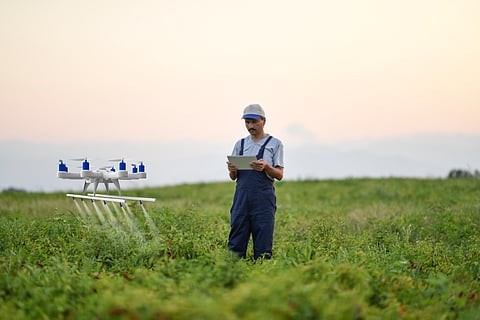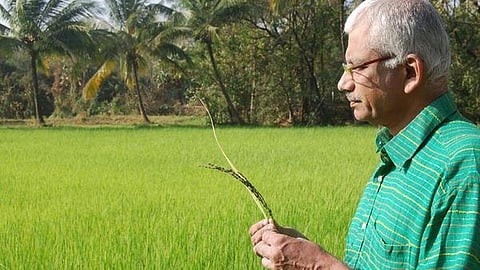Copyright infringement not intended
Picture Courtesy: Down to Earth
Context:
Agricultural drones are rapidly changing the way food is grown globally. They offer multiple functions such as spraying, seeding, monitoring crops, and mapping fields. Their adoption is especially fast in Asia, saving farmers time and reducing labour costs.
Current Status:
- Over 300,000 agricultural drones were in operation worldwide by end‑2023, covering more than 500 million hectares of farmland.
- The global agricultural‑drone market is projected to grow sharply: from about US$2.01 billion in 2024 to around US$8.03 billion by 2029. (Source: Global Agriculture)
- According to Industry Research, India’s agricultural‑drone market in 2025 is estimated at around US$155‑160 million, with potential growth to over US$2.2 billion by 2034.

Picture Courtesy: Down to Earth
What are Agricultural drones?
Agricultural drones are unmanned aerial vehicles (UAVs) specifically designed for farming and agricultural purposes. They are equipped with cameras, sensors, and spraying or seeding mechanisms to perform a variety of tasks that improve efficiency, reduce labor, and enhance productivity.
Key Features of Agricultural Drones
- Multifunctional Capabilities – Can spray fertilizers, pesticides, herbicides, sow seeds, or transport small loads.
- Monitoring & Data Collection – Equipped with cameras and sensors (RGB, multispectral, thermal) to monitor crop health, soil conditions, and water stress.
- Precision Farming – Ensures accurate application of inputs like water, fertilizer, and pesticides, reducing waste and increasing yield.
- Remote Operation – Controlled via remote controllers or smartphones, enabling work on large or hard-to-reach fields without physical strain.
Benefits
- Saves time and labor.
- Reduces direct exposure of farmers to harmful chemicals.
- Improves productivity and crop management.
- Makes agriculture more attractive to rural youth by introducing technology.
Multi-dimensional implication:
Economic Implications
- Cost Savings: Drones reduce labor costs and minimize wastage of fertilizers, pesticides, and water.
- Increased Productivity: Precision spraying and seeding improve crop yields per acre.
Social Implications
- Attracting Youth: Technology makes farming more appealing to rural youth, addressing the trend of urban migration.
- Skill Development: New employment opportunities arise for drone operators, maintenance staff, and data analysts.
- Labor Displacement: Manual laborers involved in spraying and seeding may lose jobs, requiring reskilling programs.
Environmental Implications
- Efficient Input Use: Reduced use of fertilizers and pesticides lowers soil and water contamination.
- Sustainable Agriculture: Supports “sustainable intensification” by increasing output while using fewer resources.
- Risks: Improper use can cause drift of chemicals to nearby fields, water sources, or communities.
Policy and Governance Implications
- Regulatory Framework: India has introduced drone policies for licensing, safety, and training to regulate usage.
- Government Support: Subsidies, incentives, and pilot programs are promoting adoption among smallholder farmers.
- Rural Development: Drones contribute to smart agriculture initiatives and “Digital India” goals.
Technological Implications
- Precision Agriculture: Enables real-time monitoring of crop health using sensors and imaging.
- Data-Driven Farming: Drones provide insights for predictive analytics, irrigation planning, and disease management.
- Innovation Boost: Encourages domestic drone manufacturing and research in agri-tech.
Challenges in implementing agricultural drones in India:
- High Initial Cost: Many small and marginal farmers cannot afford drones, even with subsidies. Hiring services can still be expensive for small landholdings.
- Skill and Training Gaps: Operating and maintaining drones requires technical expertise, which is limited in rural areas.
- Regulatory Hurdles: Complex regulations for drone registration, airspace clearance, and safety standards can slow adoption.
- Infrastructure Limitations: Poor internet connectivity, electricity issues, and lack of local repair facilities hinder effective drone usage.
- Environmental and Safety Concerns: Improper spraying can damage crops, pollute water bodies, or affect neighbouring farms.
- Resistance to Change: Traditional farmers may be reluctant to adopt unfamiliar technology.
Government Measures:
- Under the Sub‑Mission on Agricultural Mechanization (SMAM) farmers, farmer‑producer organisations (FPOs), custom‑hiring centres and demonstration institutions receive subsidies for purchasing drones.
- The Kisan Drone Scheme (launched in 2022) supports drone use for spraying, seeding and crop‑monitoring, encouraging the establishment of custom centres.
- The NAMO Drone Didi Scheme (approved in 2023) targets women’s self‑help groups, offering up to ~80% subsidy on drone purchases and training them as operators.
- The Production‑Linked Incentive Scheme for Drones funds domestic manufacturing of drones and components (e.g., ₹120 crore outlay) to lower costs and improve access.
- The Drone Rules 2021 simplified permissions for drone usage by reducing number of forms and establishing the digital platform “Digital Sky” for registrations.
Way forward:
- Wider Adoption Among Smallholders – Expand subsidies and training for small and marginal farmers to increase drone access beyond large farms and FPOs.
- Skill Development – Set up certified training centres for drone pilots, including rural youth and women, creating employment opportunities and addressing skill gaps.
- Research and Innovation – Promote R&D in AI-driven drone technology, precision spraying, crop monitoring, and local manufacturing to reduce costs and improve efficiency.
- Environmental Safety Measures – Develop strict protocols for pesticide use, flight paths, and chemical handling to minimize environmental contamination and health risks.
- Integration with Smart Agriculture – Combine drones with IoT sensors, satellite imagery, and AI analytics for precision farming, resource optimization, and better yield prediction.
- Regulatory Simplification – Continue easing registration, operation, and licensing processes while maintaining safety standards to encourage adoption.
- Public-Private Partnerships – Encourage collaborations between government, tech companies, and farmer cooperatives to scale drone services efficiently and affordably.
Conclusion:
Agricultural drones are transforming Indian farming by improving efficiency, reducing labor intensity, and promoting safer practices. While they offer immense potential for enhancing productivity, attracting rural youth, and supporting sustainable agriculture, challenges like high costs, skill gaps, and environmental risks need careful management. With supportive government policies, training programs, and technological innovation, drones can play a pivotal role in modernizing Indian agriculture, boosting farmers’ income, and contributing to long-term food security.
Source: Down to Earth
|
Practice Question
Q. Examine the role of agricultural drones in transforming Indian agriculture. Discuss their benefits, challenges, and the measures taken by the government to promote their adoption (250 words)
|
Frequently Asked Questions (FAQs)
Agricultural drones are unmanned aerial vehicles (UAVs) used in farming for tasks like crop monitoring, spraying pesticides, sowing seeds, and mapping fields. They help improve efficiency and reduce manual labour.
They save time, reduce labor costs, minimize exposure to harmful chemicals, increase precision in spraying and seeding, and can improve crop yields.
Yes. Improper use can lead to chemical drift affecting neighbouring farms, water sources, and human health. Drones may also displace some manual labour jobs.










